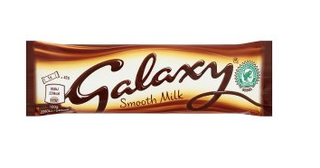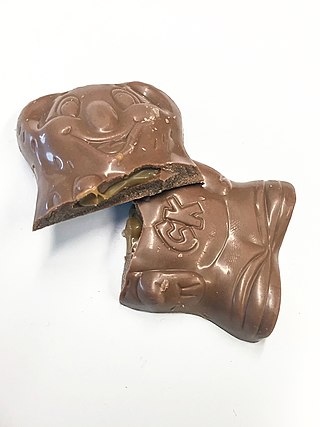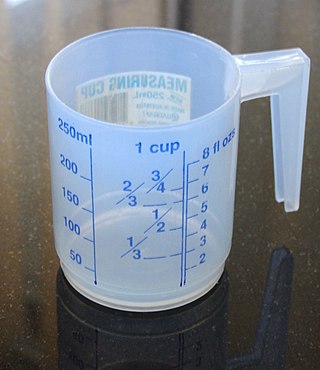
Mars, commonly known as Mars bar, is the name of two varieties of chocolate bar produced by Mars, Incorporated. It was first manufactured in 1932 in Slough, England by Forrest Mars, Sr. The bar consists of caramel and nougat coated with milk chocolate.

A drink can is a metal container designed to hold a fixed portion of liquid such as carbonated soft drinks, alcoholic drinks, fruit juices, teas, herbal teas, energy drinks, etc. Drink cans are made of aluminum or tin-plated steel. Worldwide production for all drink cans is approximately 370 billion cans per year.

Snickers is a brand of chocolate bar consisting of nougat topped with caramel and peanuts, all encased in milk chocolate. The bars are made by the American company Mars Inc. The annual global sales of Snickers is over $380 million, and it is widely considered the bestselling candy bar in the world.

A steel can, tin can, tin, or can is a container made of thin metal, for distribution or storage of goods. Some cans are opened by removing the top panel with a can opener or other tool; others have covers removable by hand without a tool. Cans can store a broad variety of contents: food, beverages, oil, chemicals, etc.

Tang is an American drink mix brand that was formulated by General Foods Corporation food scientist William A. Mitchell and General Foods Corporation chemist William Bruce James in 1957, and first marketed in powdered form in 1959. The Tang brand is currently owned in most countries by Mondelēz International, a North American company spun off from Kraft Foods in 2012. Kraft Heinz owns the Tang brand in North America.

Galaxy is a chocolate bar, made and marketed by Mars Inc., and first manufactured in the United Kingdom in the 1960s. Galaxy is sold in the United Kingdom, Ireland, South Africa, the Middle East, Morocco, India, Pakistan, Malta, and is also sold in the United States, Canada, Mexico and various Continental European countries as Dove. In 2014, Galaxy was ranked the second-best-selling chocolate bar in the UK, after Cadbury Dairy Milk.

Reese's Peanut Butter Cups are an American candy by the Hershey Company consisting of a peanut butter filling encased in chocolate. They were created on November 15, 1928, by H. B. Reese, a former dairy farmer and shipping foreman for Milton S. Hershey. Reese was let go from his job with Hershey when the Round Barn which he managed was shut down for cost-saving measures. He subsequently decided to start his own candy business. Reese's are a top-selling candy brand worldwide, with more than $2 billion in annual sales.

The system for mail delivery in the United States has developed with the nation. Rates were based on the distance between sender and receiver in the nation's early years. In the middle of the 19th century, rates stabilized at one price regardless of distance. Rates were relatively unchanged until 1968 when the price was increased every few years by a small amount. Comparing the increases with a price index, the cost of a first-class stamp has been steady. The seal of the Post Office Department showed a man on a running horse, even as railroads and, later, motorized trucks and airplanes moved mail. In 1971, the Post Office became the United States Postal Service, with rates set by the Postal Regulatory Commission, with some oversight by Congress. Air mail became standard in 1975. In the 21st century, prices were segmented to match the sorting machinery used; non-standard letters required slightly higher postage.

Tropicana Brands is an American fruit-based beverage company. It was founded in 1947 by Anthony T. Rossi in Bradenton, Florida. Between 1998 and 2021 it was a subsidiary of PepsiCo. In August 2021, 61% of Tropicana was sold along with the rest of PepsiCo's juice brand portfolio for $3.3 billion to PAI Partners. PepsiCo retained the remaining 39% of the companies ownership.

Caramello Koala is a brand of chocolate treat currently manufactured by Cadbury Australia. It consists of a chocolate cartoon koala with a caramel centre.
The spread of metrication around the world in the last two centuries has been met with both support and opposition.

Metrication, the process of introducing the metric system of measurement in place of imperial units, has made steady progress in the United Kingdom since the mid-20th century but today remains equivocal and varies by context. Most of government, industry, commerce, and scientific research use the metric system. Imperial units are officially used to specify journey distances, vehicle speeds and the sizes of returnable milk containers, beer and cider glasses, fresh milk is often still sold in multiples of pints, with the metric equivalent also marked, and precious metals are sold by the troy ounce. Metric units must be used when selling other packaged or loose goods, and imperial units can stand alongside the metric units, but it cannot stand out more than the metric units. Imperial units are also often used to describe body measurements and vehicle fuel economy. The national curriculum requires metric units and imperial units that still remain in common usage to be taught in state schools.

The cup is a cooking measure of volume, commonly associated with cooking and serving sizes. In the US, it is traditionally equal to one-half US pint (236.6 ml). Because actual drinking cups may differ greatly from the size of this unit, standard measuring cups may be used, with a metric cup being 250 millilitres.

A blister pack is any of several types of pre-formed plastic packaging used for small consumer goods, foods, and for pharmaceuticals.

Cotton duck, also simply duck, sometimes duck cloth or duck canvas, is a heavy, plain woven cotton fabric. Duck canvas is more tightly woven than plain canvas. There is also linen duck, which is less often used.

Yorkie is a chocolate bar made by Nestlé. It was originally made by York-based company Rowntree's, hence the name.
California Redemption Value (CRV), also known as California Refund Value, is a regulatory fee paid on recyclable beverage containers in the U.S. state of California. The fee was established by the California Beverage Container Recycling and Litter Reduction Act of 1986 and further extended to additional beverage types in California State Senate Bill No. 1013, signed into law on September 28, 2022 and taking effect on January 1, 2024; since 2010 the program has been administered by the Cal/EPA California Department of Resources Recycling and Recovery (CalRecycle).

Twirl is a chocolate bar manufactured by the British chocolate brand Cadbury. Twirl was invented in Dublin by Cadbury Ireland, and launched there in 1985 as a single-finger bar. It was released in the UK two years later as a twin-finger bar. It has been marketed internationally since the 1990s and is now one of the best-selling chocolate Cadbury products. Twirl consists of two Flake-style fingers covered in milk chocolate.
A product's average price is the result of dividing the product's total sales revenue by the total units sold. When one product is sold in variants, such as bottle sizes, managers must define "comparable" units. Average prices can be calculated by weighting different unit selling prices by the percentage of unit sales (mix) for each product variant. If we use a standard, rather than an actual mix of sizes and product varieties, the result is price per statistical unit. Statistical units are also called equivalent units.

A worldwide surge in inflation began in mid-2021, with many countries seeing their highest inflation rates in decades. It has been attributed to various causes, including COVID-19 pandemic-related economic dislocation, supply chain disruptions, the fiscal and monetary stimuli provided in 2020 and 2021 by governments and central banks around the world in response to the pandemic, and price gouging. Recovery in demand from the COVID-19 recession had by 2020 led to significant supply shortages across many business and consumer economic sectors. The inflation rate in the United States and the eurozone peaked in the second half of 2022 and sharply declined in 2023 and into 2024. Despite its decline, significantly higher price levels across various goods and services relative to pre-pandemic levels persist, which some economists speculate is permanent.























